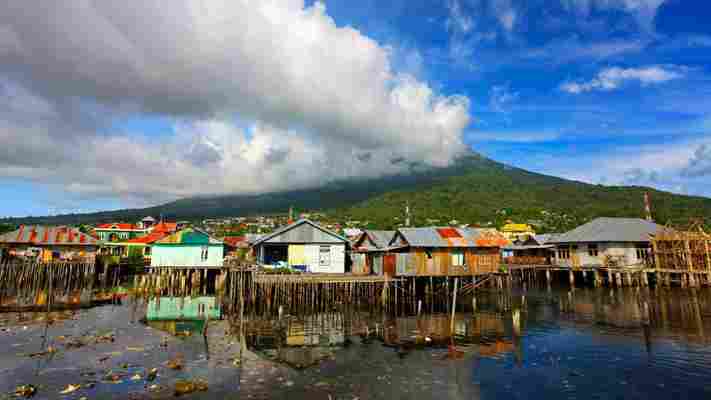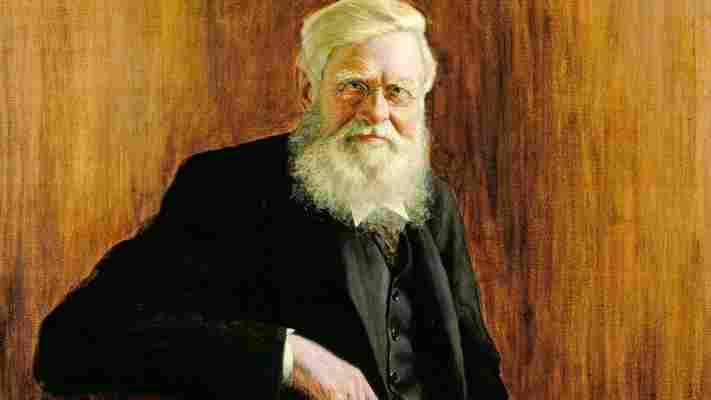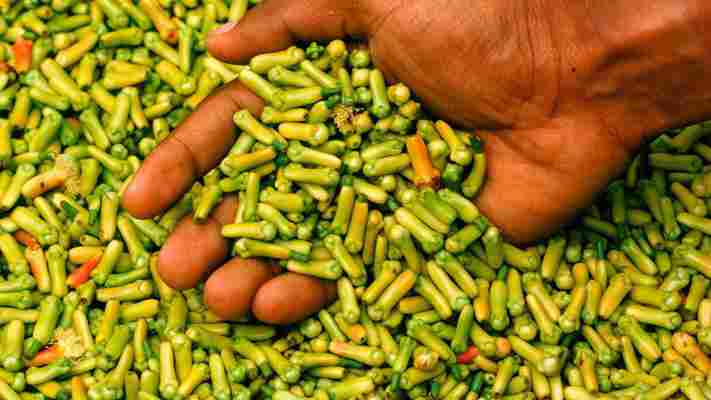Article continues below
The Indonesian island of Ternate, like its neighbour Tidore, is almost all volcano. It sprouts from the sea, an almost-perfect, yet truncated cone, wreathed in steamy clouds and fringed with a narrow strip of flatlands and beach that house an airport, a city and an around-the-island road.

The theory of evolution through natural selection was outlined on Ternate island, Indonesia (Credit: Ali Trisno Pranoto/Getty)
Even in the run-up to the tourist event of the millennium, the full solar eclipse of March 2016, Ternate felt a remote place: the sort of island where it’s hard for a foreigner to cover more than a few metres without being enlisted for a group selfie, and small children greet you, gender regardless, with cheery cries of ‘Hello Mister!’ It seems an implausible location, all in all, for one of science’s great eureka moments, when a Victorian naturalist put pen to paper and outlined the theory of evolution through natural selection.
It seems an implausible location, all in all, for one of science’s great eureka moments
When 35-year-old Alfred Russel Wallace arrived in Ternate in January 1858, he’d been exploring the vast and sprawling mass of islands he called the Malay Archipelago for almost four years. Travelling thousands of miles by steamer, sailing ships and native boats, on horseback and on foot, he and his assistants had killed, skinned or pinned tens of thousands of specimens, from orangutans to birds of paradise to the sloth-like marsupial known as the cuscus, not to mention thousands of species of beetle.
By then, Ternate’s glory days were over, swept away by colonisation. For millennia, cloves had grown only on Ternate, Tidore and a handful of nearby islands – and for more than 3,000 years they’d crossed continents in an elaborate web of barter and trade, gaining value with each transaction. Enriched by this precious traffic, the sultans of Ternate laid claim to an empire that stretched as far as the Philippines and Papua – and engaged in vicious rivalry with the sultans of equally tiny Tidore.

Alfred Russel Wallace visited Ternate in 1858 to continue his research on the Malay Archipelago (Credit: The Natural History Museum/Alamy)
Today the piney, mulled-wine scent of drying cloves sweeps across the island during harvest time, and clove trees clothe the volcano’s lower slopes: small boys in nylon football shorts wait by the roadside to escort you to the towering tree that is, they claim, the oldest in the world. But first the Dutch, then the British broke the sultans’ clove monopoly. By 1858, the island that had attracted the pirate-navigator Francis Drake and the explorer Ferdinand Magellan was a backwater.
Wallace took a tumble-down house surrounded by fruit trees, five minutes’ walk from the market on the outskirts of what is now Ternate City. Although local guides promote several different houses as the spot where Wallace lived, it’s almost certainly long gone.
“There were two roads that it could have been along, given the information he gave us,” said Wallace expert John Van Wyhe of the National University of Singapore. “There are no houses even half the age they should be.”

For thousands of years, cloves could only be found on Ternate and a handful of nearby islands (Credit: Bruce Dale/Getty)
Wallace had barely moved in to his shady house with its cool, freshwater well when he fell sick, most likely with malaria. Cold sweats alternated with hot fits, and Wallace had to lie down for hours at a time, with nothing to do but think. Far from home, freezing or sweltering in the shadow of the volcano, quite likely in fear for his life, Wallace’s mind turned to Thomas Malthus, the Georgian-era intellectual who had argued that nature kept human populations down by disease, famine, war and accidents – and realised a similar logic could apply to animal species.
During his travels through what is today mostly Indonesia, Wallace had seen thousands of thought-provoking creatures. There was the flying frog, which demonstrated how toes already adapted for swimming and climbing could be used to soar through the air. There were orangutans, which perhaps had their own ancestors, like chimpanzees and gorillas; Wallace had tended a baby as a pet. Sickness – and perhaps with it the prospect of his own extinction – concentrated his mind.
“Vaguely thinking over the enormous and constant destruction which this implied, it occurred to me to ask the question, why do some die and some live?” he later wrote. “And the answer was clearly, that on the whole, the best fitted live.” Natural selection was, Wallace realised in a flash, the mechanism by which species evolved and came to be.
Wallace’s experience with different animal species inspired his theory of natural selection (Credit: De Agostini/Biblioteca Ambrosiana/Getty)
Inspired, Wallace waited anxiously for his fever to pass, and quickly noted down the outline of a paper. Over the next couple of evenings, he worked his theory up, and sent it to Charles Darwin, already a respected scientist.
When the letter arrived in England, on 18 June 1858, it threw Darwin into something of a panic. He had been working on his own theory of evolution by natural selection for almost 20 years, and was about a year off finishing what would have been a massive, three-volume epic on the subject. Nonetheless, he did the right thing, and the men’s colleagues presented both ideas of natural selection together a fortnight later.
If it hadn’t been for Wallace interrupting Darwin, he’d have carried on and written this big book which probably no one would have read
“Then everyone said, ‘Gosh, this is really interesting, can you tell us about your theory? We can’t wait for this big book to be finished,’” Wyhe said. “That book became On the Origin of Species. If it hadn’t been for Wallace interrupting Darwin, he’d have carried on and written this big book which probably no one would have read.” As it is, Darwin published the book in November 1859, shaking the world of religion and shaping the world of science.
And Wallace? He continued his travels. In 1859, he laid down a landmark in the field of biogeography, tracing a line that delineates the boundaries of Southeast Asian and Australian fauna: the Wallace Line. In 1862, he returned to England, having collected no fewer than 125,660 natural history specimens, including more than 83,000 beetles. In 1868, he published an endlessly readable memoir of his travels, The Malay Archipelago. He would live till the age of 90, writing in support of causes as diverse as women’s rights and spiritualism, and never failing to extend his colleague Darwin the respect that he deserved.
Wallace and Charles Darwin’s theories of natural selection were presented together in 1858 (Credit: Peter MacDiarmid/Getty)
Places That Changed the World is a BBC Travel series looking into how a destination has made a significant impact on the entire planet.
Join over three million BBC Travel fans by liking us on Facebook , or follow us on Twitter and Instagram .
If you liked this story, sign up for the weekly bbc.com features newsletter called "If You Only Read 6 Things This Week". A handpicked selection of stories from BBC Future, Earth, Culture, Capital and Travel, delivered to your inbox every Friday.
